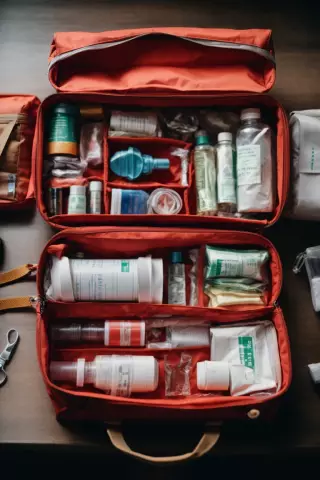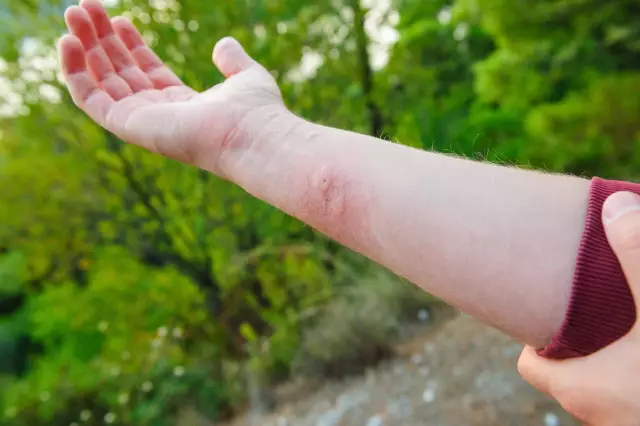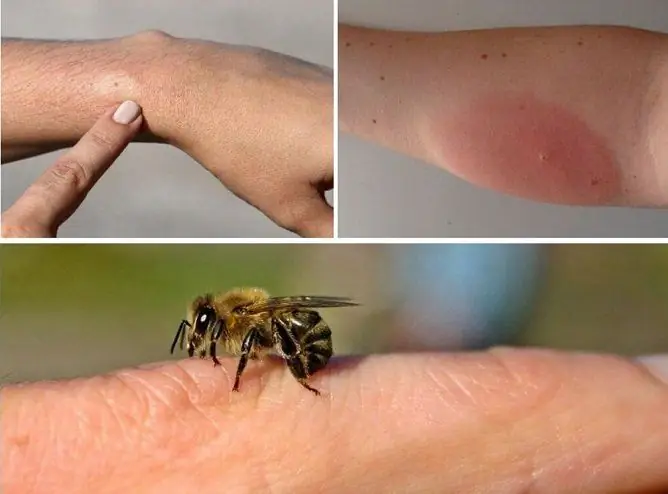- Author Rachel Wainwright [email protected].
- Public 2023-12-15 07:39.
- Last modified 2025-11-02 20:14.
First aid for a bee sting
In folk medicine, it is believed that bee stings are good for health, there is a whole section of medicine - apitherapy, which is devoted to the treatment of various diseases with bee venom. However, a bee sting, besides being very painful, can cause an allergic reaction - that is why it is necessary to be able to provide first aid.
Essential information about bee stings

To understand how to act correctly, you need to know the following. The bee sting is connected to a special reservoir in the bee's abdomen that contains venom. When bitten, a serrated sting usually gets stuck in the skin and breaks off. Often, along with the sting, a bag of poison attached to it remains, and the poison continues to enter the bloodstream even after direct contact with the bee has been interrupted. That is why it is imperative to remove the sting from the wound, do it quickly and very carefully so as not to inject the poison from the bag into the bite site yourself.
Bee venom has an acidic reaction (unlike wasp venom, which has an alkaline reaction), so alkalis help to neutralize it - liquid soap, soap solution, baking soda solution.
First aid for a bee sting
So, after a person has felt a sharp burning pain from a bee sting, the following must be done:
-

Bee sting in human skin Carefully examine the bite site, which looks like a raised red spot (papules) above the skin - a sting should be visible in the center. If it is not there, two options are possible - either the sting is inside the wound, or the victim was stung by a wasp;
- The sting must be removed. This can be done with tweezers or nails. If the sting is in the wound, it should be squeezed out of there, and you need to continue pressing until a drop of blood appears from the wound - this way you can remove most of the poison. You can use a regular sewing needle to remove the sting, however, before use, the needle must be calcined over a fire or treated with an antiseptic. The wound should also be disinfected;
- Treat the bite site with an antiseptic - any that is at hand will do;
- Apply cold to the bite site. Any cold object will do, however it is important that it is clean, otherwise there is a risk of infection;
- Apply for 15-20 minutes to the wound a piece of bandage or cotton wool soaked in soda solution (1 teaspoon of soda per glass of water), a compress with soda gruel (add a few drops of water to a teaspoon of soda and stir until mushy);
- The bitten area can be treated with a local antihistamine (antiallergic) agent, for example Fenistil in the form of a gel or Psilo-balm;
- Take an antihistamine orally. This first aid measure is necessary if there is a too violent reaction of the body (the appearance of general symptoms, suffocation, skin rash, edema, enlarged papules, etc.), if the victim is prone to allergies (without waiting for its symptoms), and in children under 12 years of age.
It is also recommended to give the victim plenty of drink - water, sweet tea, compote, etc. in order to reduce the concentration of poison in the body and accelerate its excretion.
As a rule, these actions are sufficient to relieve pain and prevent possible unpleasant consequences of a bite.
When you need medical attention

2% of people have an allergic reaction to bee stings. This means that under certain conditions, the ingress of bee venom into their body can cause a severe reaction, up to and including death. In this case, first aid measures are not enough and you cannot do without emergency medical help. Also, bites in some particularly vulnerable areas of the body are at increased risk.
Urgent medical attention is needed in the following situations:
- Multiple bites. In this case, a high dose of bee venom can lead to the most serious consequences, up to respiratory arrest;
- Bites in the neck, mouth, eyes. In the first two cases, suffocation is possible due to edema of the tissues of the upper respiratory tract, bee stings in the eye area can cause severe inflammation;
- Having an allergic reaction to the bite. The following symptoms should be alerted: the appearance of shortness of breath, perspiration and / or cramps in the throat, a feeling of tightness in the chest, as well as massive swelling, rash, nausea, vomiting, difficulty breathing, loss of consciousness.
In all these cases, an ambulance should be called, or the victim should be taken to the hospital as soon as possible. You also need to see a doctor if pain, swelling and redness at the site of the bite do not decrease within three days.
Folk first aid
First aid is most effective, provided in the first minutes after the bite. But bees often sting people away from home or pharmacy. In this case, you can resort to one of the folk methods:
- Treat the bite site with dandelion milky juice or a crushed leaf of one of the medicinal plants: thyme, sage, chamomile;
- If none of the above is at hand, you can urinate on the wound. Fresh urine has anti-inflammatory and disinfectant properties.
Dos and Don'ts for Bee Stings
It is widely believed that bee venom is easily neutralized by alcohol taken internally, so you can often find advice to drink 30-50 g of vodka or brandy if you are stung by a bee. For obvious reasons, this "treatment" is not suitable for children, however, adults should not do this either. The fact is that alcohol does not remove or neutralize toxins, but, on the contrary, facilitates their penetration into the body and complicates their excretion.
Also, when providing first aid, you do not need to do the following:
- Rub the bite site and press on it (the exception is squeezing the poison out of the wound, i.e. pressing in a special way);
- Apply earth, clay to the wound, wash and cool it with river, lake water or water from puddles. This will most likely lead to infection, up to tetanus;
- Kill the bee. Firstly, a bee that is left without a sting dies on its own. Secondly, if you crush it, special volatile substances are released, notifying the bees in the vicinity of the danger. This can attract many other bees to you, angry and ready to attack.
Found a mistake in the text? Select it and press Ctrl + Enter.






